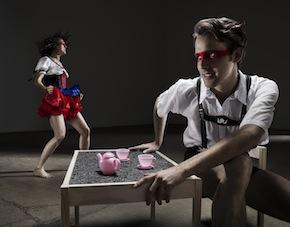Beauty and Tragedy in Gamelan Premieres

Photo by Jorge Vismara
White egrets flying into the Balinese village of Petulu every night are believed to be the spirits of those who died in the massacres of 1965-1966. Some half a million Indonesians, many of Chinese origin, were killed during the nationalistic/anti-communist campaign.
When the 34th San Francisco Ethnic Dance Festival opens on June 2, one of the works on the program will deal with those events. Dancer Ayu Larassanti and Berkeley's Gamelan Sekar Jaya perform Legong Somia, the title referring to a state of peace sought by the egrets and the souls of the dead — departing without proper final rites — they represent.
The festival opening program also features the world premiere of Bayangan Jiwa (The Spirit's Image), a work combining dance, shadow puppets, and two gamelan orchestras — Sekar Jaya and San Jose's Pusaka Sunda.
The work, says Sekar Jaya's Emiko Saraswati Susilo, "investigates how the human spirit navigates the space between darkness and light, movement and stillness, sound, and silence."

Susilo says "Balinese dance is closely tied to Balinese gamelan. Every nuance of music is interpreted by the dancers, who closely follow the instrumental changes and intricate rhythmic patterns. The dancers’ bodies are an extension of the music and instruments. Finding the breath between the two is the really exciting thing about Balinese gamelan and dance together."
Sekar Jaya will also offer "Kelanguan," an instrumental work employing complex use of overlapping time signatures and intertwining melodic motion.
The event will feature some 70 performers in ensemble, with spectacular costumes and elaborate headdresses. Shadow theater, a vital part of Balinese culture, adds playfulness and energy to the music and dance.
Susilo, daughter of noted artists and teachers Hardja Susilo and Judy Mitoma, explains the difference between different gamelan styles:
The (West Java) Sundanese features ethereal flute music and is intricate, delicate, gentle, meditative, and like from another world. Balinese gamelan, especially in this particular piece, also has meditative element to it but is characterized by dynamic energy, drama, and surprise. It can take your breath away.
The Ethnic Dance Festival, titled "The World United Through Dance," is curated by Carlos Carvajal and CK Ladzekpo. It features 30 Bay Area companies in three weeks of performances at Yerba Buena’s Novellus Theater, and other venues. The companies represent a worldwide variety of ethnic dance, from Appalachian clogging to Indian Kathak to Chinese acrobatic dance to Zimbabwean, Eastern European, Spanish flamenco, Tajik, and Uzbek. Says Festival Executive Director Julie Mushet:
[The event] brings a national focus to the importance and breadth of our companies and artists. There is no other dance community in the world with the cultural diversity, artistic excellence, and vibrancy of the San Francisco Bay Area’s.We currently serve as the hub for over 450 Bay Area dance companies who are networked with many thousands of dancers and musicians all over the world. These deep international relationships sustain and innovate more than a hundred different dance forms.
During the festival, the 2012 Dance/USA conference will be held in The City. This 30-year-old national service organization for professional dance serves more than 400 ballet, modern, ethnic, jazz, tap companies, and presenting organizations.
For festival program information, see the website, beginning with the first weekend's schedule.
Napa Valley May Get New Orchestra
Just a couple of months after our reluctant obituary for the Napa Valley Symphony comes news that former NVSA executive director Richard Aldag is going once more unto the breach with the creation of Orchestra Napa Valley.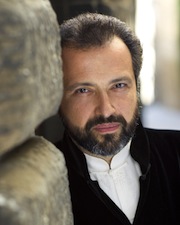
It's an initial, tentative but determined effort, described by Aldag as being "in the process of building Orchestra Napa Valley’s inaugural board of directors and raising the capital to fund its first concerts." For information about participation in the venture, Aldag may be contacted at [email protected].
The announcement says violinist-conductor Dmitry Sitkovetsky "is deeply involved in the project."
Plans call for an orchestra of about 40 musicians performing an annual subscription series of four programs in the Napa Valley Opera House, with each program presented on Friday evenings at 7 p.m. and Sunday afternoons at 4 p.m.
The orchestra would also be involved in two festival projects in venues in Napa, collaborating with other arts organizations and with local businesses to enhance cultural tourism to the Valley. Mozart Napa Valley, a project that Aldag had been developing for the Napa Valley Symphony, will launch in April 2014, and a Baroque-themed festival will launch in Oct. 2015.
"While it was disheartening to see the Napa Valley Symphony close its doors," says Aldag, "I am truly excited by the development of Orchestra Napa Valley over the past two months, the work that has been accomplished in such a short period to create a new, sustainable business model for a professional orchestra in the Napa Valley has been invigorating.”
Initial plans call for an all-string program in early March of 2013, and a full orchestral program in late April, both conducted by Sitkovetsky.
Dalis Competition Winners

Some $50,000 in prizes and important performance opportunities were awarded at the sixth annual Irene Dalis Vocal Competition on Saturday.
Of the 10 finalists selected from the three-day West Coast auditions, soprano Rebecca Davis won the $15,000 first prize with performances of "Dis-moi que je suis belle," from Massenet’s Thais and "Dove sono i bei momenti," from Mozart’s The Marriage of Figaro.
Mezzo Maria McDaniel won second prize, tenor Cesar Sanchez took third prize (and also the Audience Favorite Prize). The other finalists were: sopranos Kearstin Piper Brown, Christie Hageman, Christina Major; mezzo Julie Anne Miller; tenor Mathew Edwardsen; baritone Krassen Karagiozov; and bass Silas Elash.
Judges for the competition were Henry Akina, Hawaii Opera Theatre; Ward Holmquist, Lyric Opera of Kansas City; and Brad Trexell, Opera Colorado. The preliminary panel of judges consisted of Richard Harrell, S.F. Conservatory of Music; Peter Jaffe, Stockton Symphony; and Timm Rolek, Lake Tahoe Music Festival.
Joe Goode, Falling Apart
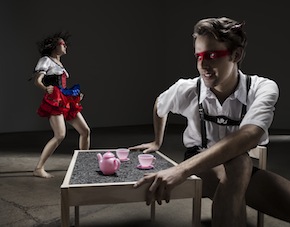
Photo by RJ Muna
Z Space presents the Joe Goode Performance Group in the world premiere of When We Fall Apart, dance theater exploring "the intricate and fragile relationship between house and body, and what defines a home." It will be performed June 13-30 at Z Space, 450 Florida St., S.F.
Goode, winner of numerous awards for his innovative work combining dance and performance art, is collaborating with architect Cass Calder Smith, who is best known for his high-profile restaurant designs in San Francisco and New York. This is the first time Smith’s work will be integrated into a live stage performance. The evening-length work is built for seven dancers, and features live, original music by Ben Juodvalkis of the band Battlehooch.
Goode speaks of "home" in terms of "stability, safety, and family even at a time of record-high home foreclosures. At the same time our body is often figured as a home, housing our feelings and ideas — and it is equally susceptible to loss and decay."
But Goode is expanding the idea even further:
For me, the house represents the good life, the sturdy, normal life that I aspire to but never seem to find. As a gay person I am not allowed access to that house as it symbolizes marriage, home, family.Somehow the symbol represents something that is off limits to me. When We Fall Apart investigates this "myth" of stability and how it consistently eludes us. Life (and the body that contains it) is impermanent and at a certain point the house collapses and gives way. Yet we are compelled as a species to build that structure to try to ward off the inevitable.
Tales from the Big Apple
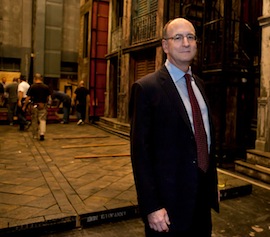
Photo by Sara Krulwich/The New York Times
On Monday, the front page of The New York Times featured a laudable piece of opinion journalism: Ben Brantley called an end to standing ovations:
[At the final curtain for the opening of the revival of Gentlemen Prefer Blondes] ... we stayed in our seats. We whooped, we roared, we beat our hands raw with clapping. But no one, as far as I could see, was standing up. Gentlemen Prefer Blondes had been accorded the five-star tribute of a sitting ovation.To go one better, the Tuesday paper carried Daniel J. Wakin's "scoop" on what just about everybody in the opera world knew already:I would like to make the case, officially and urgently, for the return of the sitting ovation. Because we really have reached the point at which a standing ovation doesn’t mean a thing. Pretty much every show you attend on Broadway these days ends with people jumping to their feet and beating their flippers together like captive sea lions when the zookeeper arrives with a bucket of fish. This is true even for doomed stinkers that find the casts taking their curtain calls with the pale, hopeless mien of patients who have just received a terminal diagnosis.
Opera News ... said on Monday that it would stop reviewing the Metropolitan Opera, a policy prompted by the Met’s dissatisfaction over negative critiques.The decision by the magazine, which is published by a Met fund-raising affiliate, the Metropolitan Opera Guild, and which freely reviews companies around the world, troubles some opera experts. It is also the latest sign of sensitivity from the Met under its general manager, Peter Gelb, in the face of criticism over its productions.
The move came after a review in April took aim at the Met’s new production of Wagner’s Ring cycle — a hallmark of Mr. Gelb’s tenure that has led to a firestorm — and after a top Opera News editor criticized the Met’s direction in a scathing essay in the May issue.
Klein String Competition Coming Up
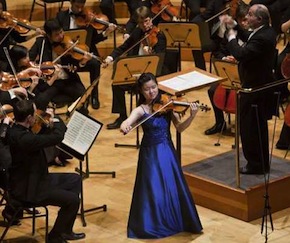
Photo by Scott Chernis
Winners receive prizes and performance opportunities with Marin Symphony, San Jose Chamber Orchestra, Peninsula Symphony Orchestra, Noontime Concerts, and Music in the Vineyards.
The contest is for string players ages 15 to 23. Mitchell Sardou Klein has been artistic director of the competition since its inception in 1986. He says:
Past winners continue to tell us that the concert appearances they receive are priceless, propelling their careers more than anything else related to the competition. Nothing parallels performing a major concerto work with an outstanding orchestra in front of a full house. It is the real deal. We are grateful to our donors and community partners for making these opportunities possible.This year’s grand prize is given in memory of Marvin T. Tepperman; the second prize is given by Ruth Short in honor of Elaine H. Klein. Winners also receive the opportunity to make presentations and conduct master classes in schools on the Peninsula and in San Francisco.
This year’s semifinalists were selected from 78 entrants from three continents and some of the nation’s top conservatories. More than 25 percent of this year’s Klein applicants attend the Juilliard School.
The semifinalists are:
- * Sarah Harball, 23, violist born in Seattle, studies with Atar Arad at Indiana University’s Jacobs School of Music
* Austin Huntington, 17, cellist born in Saint Joseph, MI., studies with Richard Hirschl and attends St. Joseph’s High School in South Bend, Ind.
* Chris Irvine, 21, cellist born in Oberlin, OH, studies with Paul Katz at New England Conservatory of Music
* Jean Kim, 16, cellist born in Sleepy Hollow, NY, studies with Minhye Clara Kim and attends Sleepy Hollow High School and the Juilliard School Pre-College Division
* Natalie Lin, 23, violinist born in New Zealand, studies with Paul Kantor at Cleveland Institute of Music.
* Richard Narroway, 20, cellist from Australia, studies with Hans Jorgen Jensen at Northwestern University
* Su Hyun Park, 20, violinist born in South Korea, studies with Ronald Copes and Donald Wellerstein at Juilliard
* Emma Steele, 22, violinist born in Chicago, studies with Cyrus Forough at Carnegie Mellon University
* Alexandra Switala, 18, violinist born in Irving, Texas, studies with Roland and Almita Vamos and is home-schooled in Grapevine, TX
SFS Youth Orchestra Sails for Europe
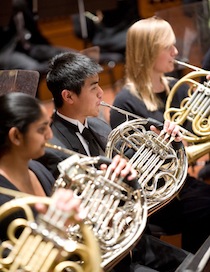
The orchestra's Bon Voyage concert on June 16 at Davies Symphony Hall features Garrick Ohlsson in the Grieg Piano Concerto; Prokofiev’s Symphony No. 5 is also on the program, conducted by Donato Cabrera.
Tour repertoire consists of Bay Area composer John Adams’s Shaker Loops, Mahler’s Symphony No. 1, Prokofiev’s Symphony No. 5, and Berlioz’ Roman Carnival Overture. Pianist Lars Vogt joins the SFSYO tour, performing the Grieg Piano Concerto in A Minor. The orchestra consists of some 100 young people, ranging from age 12 to 21. The average tenure of musicians is three to four years. On the first tour of Europe, in 1986, the Youth Orchestra won the City of Vienna Prize at the International Youth and Music Festival.
S.F. Ballet School Student Showcase
San Francisco Ballet's Ballet School presents its annual Student Showcase — of class demonstrations and repertory works — in the Novellus Theater at Yerba Buena Center for the Arts, May 30-June 1. A fund-raising dinner following the May 31 performance will honor Ballet School Associate Director Lola de Avila, who will be stepping down in August to oversee the full-time operation of the Maria de Avila Ballet School in her native Spain.Under de Avila’s direction, the school embarked on its first European audition tour earlier this year; its men’s program was expanded and strengthened; a standard for curriculum was set; and currently, over half of the company members have received their training at the Ballet School. Patrick Armand assumes the duties of associate director on September 1. (The school's director is SFB Artistic Director Helgi Tomasson.)
In the Student Showcase, advanced-level students will perform George Balanchine’s Western Symphony; an excerpt from Act 2 of August Bournonville’s La Sylphide; Spinae, a work by SFB Corps de Ballet member Myles Thatcher; and Dunas, a new work by SFB Corps de Ballet member Francisco Mungamba. Both Thatcher and Mungamba trained at the SF Ballet School.

